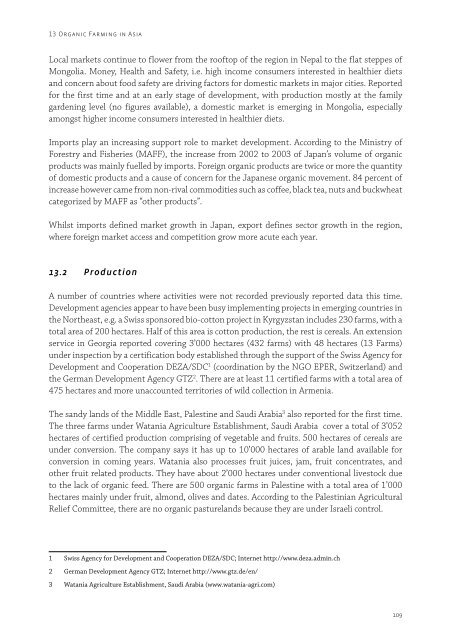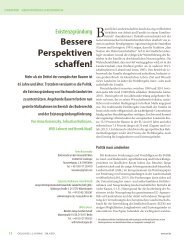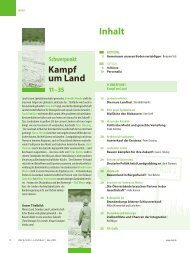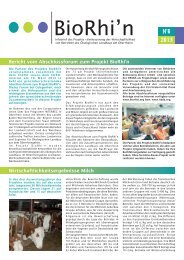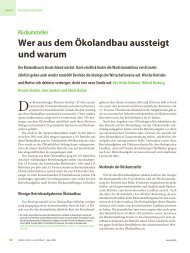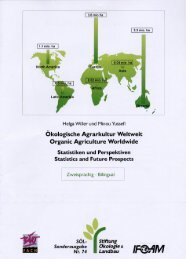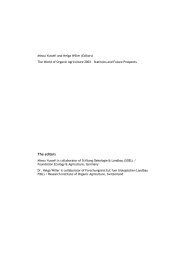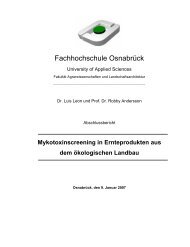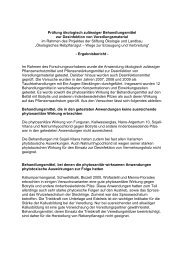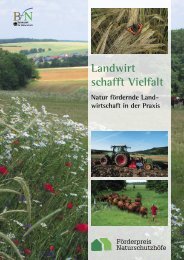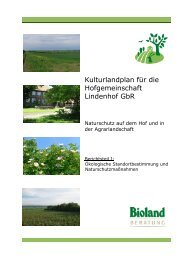the world of organic agriculture - Organic Eprints
the world of organic agriculture - Organic Eprints
the world of organic agriculture - Organic Eprints
You also want an ePaper? Increase the reach of your titles
YUMPU automatically turns print PDFs into web optimized ePapers that Google loves.
13 <strong>Organic</strong> Farming in Asia<br />
Local markets continue to flower from <strong>the</strong> ro<strong>of</strong>top <strong>of</strong> <strong>the</strong> region in Nepal to <strong>the</strong> flat steppes <strong>of</strong><br />
Mongolia. Money, Health and Safety, i.e. high income consumers interested in healthier diets<br />
and concern about food safety are driving factors for domestic markets in major cities. Reported<br />
for <strong>the</strong> first time and at an early stage <strong>of</strong> development, with production mostly at <strong>the</strong> family<br />
gardening level (no figures available), a domestic market is emerging in Mongolia, especially<br />
amongst higher income consumers interested in healthier diets.<br />
Imports play an increasing support role to market development. According to <strong>the</strong> Ministry <strong>of</strong><br />
Forestry and Fisheries (MAFF), <strong>the</strong> increase from 2002 to 2003 <strong>of</strong> Japan’s volume <strong>of</strong> <strong>organic</strong><br />
products was mainly fuelled by imports. Foreign <strong>organic</strong> products are twice or more <strong>the</strong> quantity<br />
<strong>of</strong> domestic products and a cause <strong>of</strong> concern for <strong>the</strong> Japanese <strong>organic</strong> movement. 84 percent <strong>of</strong><br />
increase however came from non-rival commodities such as c<strong>of</strong>fee, black tea, nuts and buckwheat<br />
categorized by MAFF as “o<strong>the</strong>r products”.<br />
Whilst imports defined market growth in Japan, export defines sector growth in <strong>the</strong> region,<br />
where foreign market access and competition grow more acute each year.<br />
13.2 Production<br />
A number <strong>of</strong> countries where activities were not recorded previously reported data this time.<br />
Development agencies appear to have been busy implementing projects in emerging countries in<br />
<strong>the</strong> Nor<strong>the</strong>ast, e.g. a Swiss sponsored bio-cotton project in Kyrgyzstan includes 230 farms, with a<br />
total area <strong>of</strong> 200 hectares. Half <strong>of</strong> this area is cotton production, <strong>the</strong> rest is cereals. An extension<br />
service in Georgia reported covering 3’000 hectares (432 farms) with 48 hectares (13 Farms)<br />
under inspection by a certification body established through <strong>the</strong> support <strong>of</strong> <strong>the</strong> Swiss Agency for<br />
Development and Cooperation DEZA/SDC 1 (coordination by <strong>the</strong> NGO EPER, Switzerland) and<br />
<strong>the</strong> German Development Agency GTZ 2 . There are at least 11 certified farms with a total area <strong>of</strong><br />
475 hectares and more unaccounted territories <strong>of</strong> wild collection in Armenia.<br />
The sandy lands <strong>of</strong> <strong>the</strong> Middle East, Palestine and Saudi Arabia 3 also reported for <strong>the</strong> first time.<br />
The three farms under Watania Agriculture Establishment, Saudi Arabia cover a total <strong>of</strong> 3’052<br />
hectares <strong>of</strong> certified production comprising <strong>of</strong> vegetable and fruits. 500 hectares <strong>of</strong> cereals are<br />
under conversion. The company says it has up to 10’000 hectares <strong>of</strong> arable land available for<br />
conversion in coming years. Watania also processes fruit juices, jam, fruit concentrates, and<br />
o<strong>the</strong>r fruit related products. They have about 2’000 hectares under conventional livestock due<br />
to <strong>the</strong> lack <strong>of</strong> <strong>organic</strong> feed. There are 500 <strong>organic</strong> farms in Palestine with a total area <strong>of</strong> 1’000<br />
hectares mainly under fruit, almond, olives and dates. According to <strong>the</strong> Palestinian Agricultural<br />
Relief Committee, <strong>the</strong>re are no <strong>organic</strong> pasturelands because <strong>the</strong>y are under Israeli control.<br />
1 Swiss Agency for Development and Cooperation DEZA/SDC; Internet http://www.deza.admin.ch<br />
2 German Development Agency GTZ; Internet http://www.gtz.de/en/<br />
3 Watania Agriculture Establishment, Saudi Arabia (www.watania-agri.com)<br />
109


